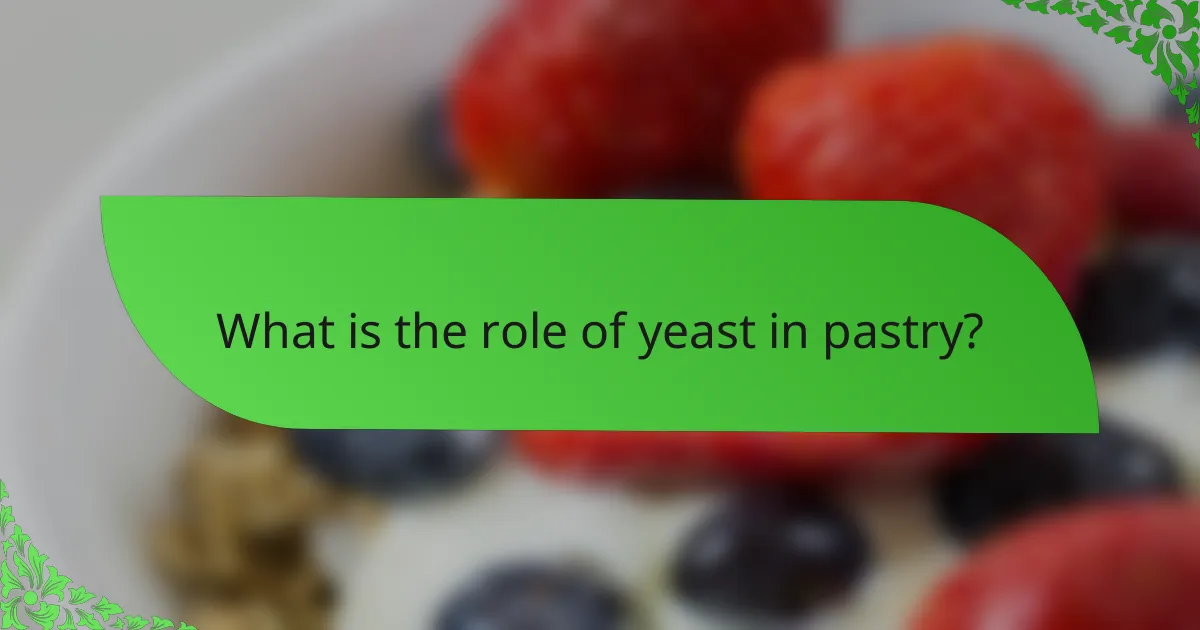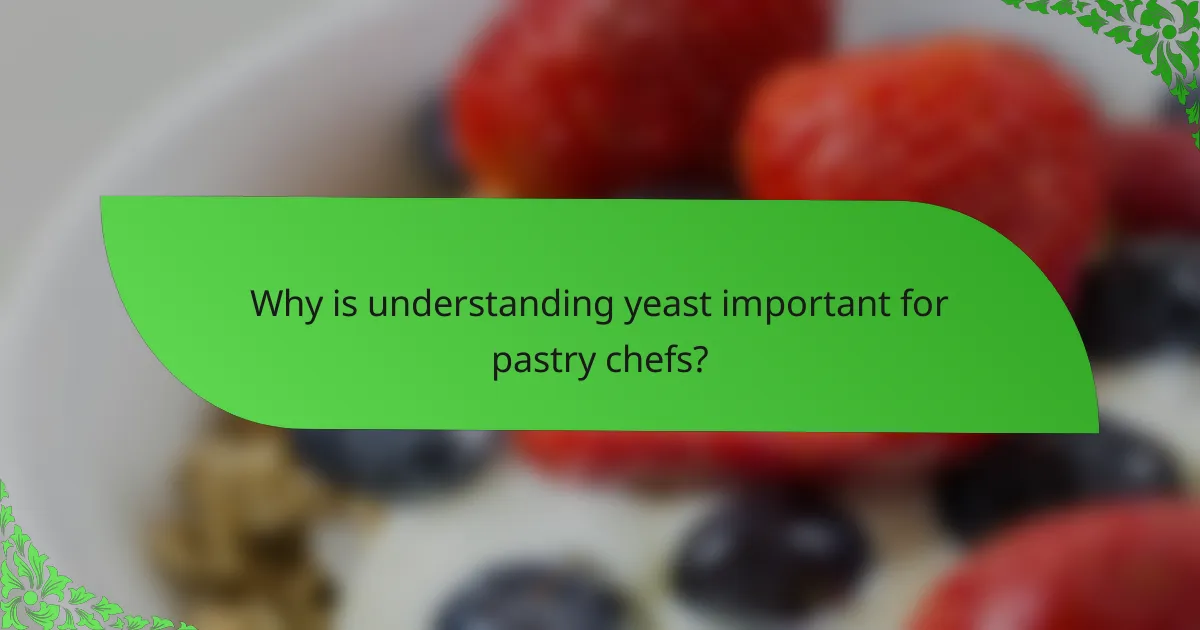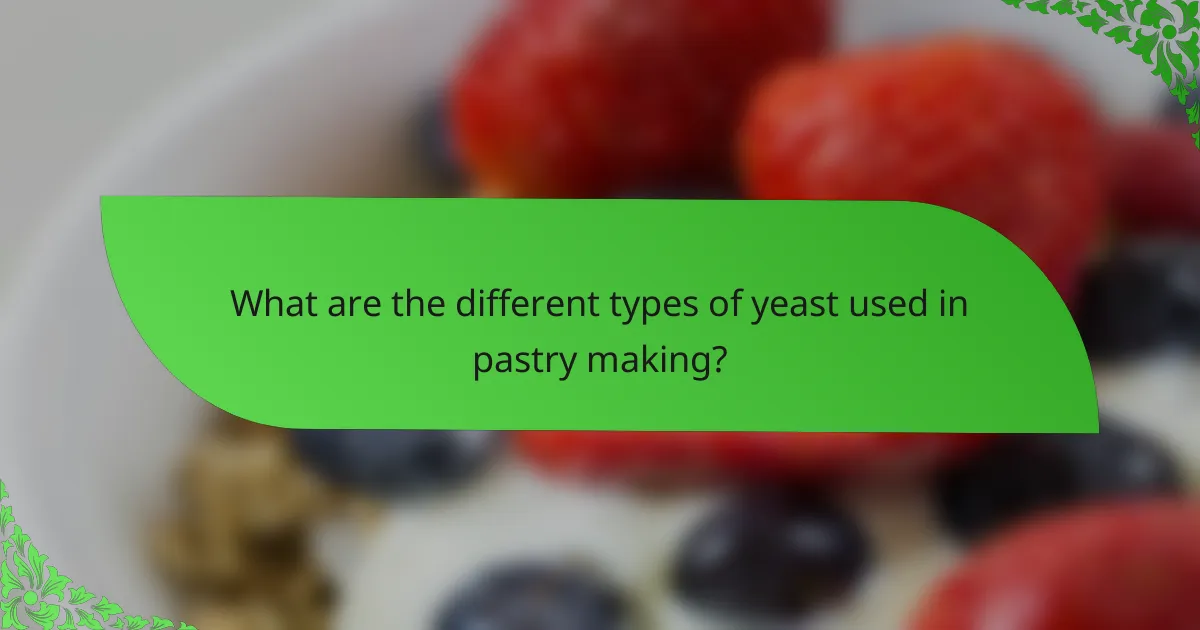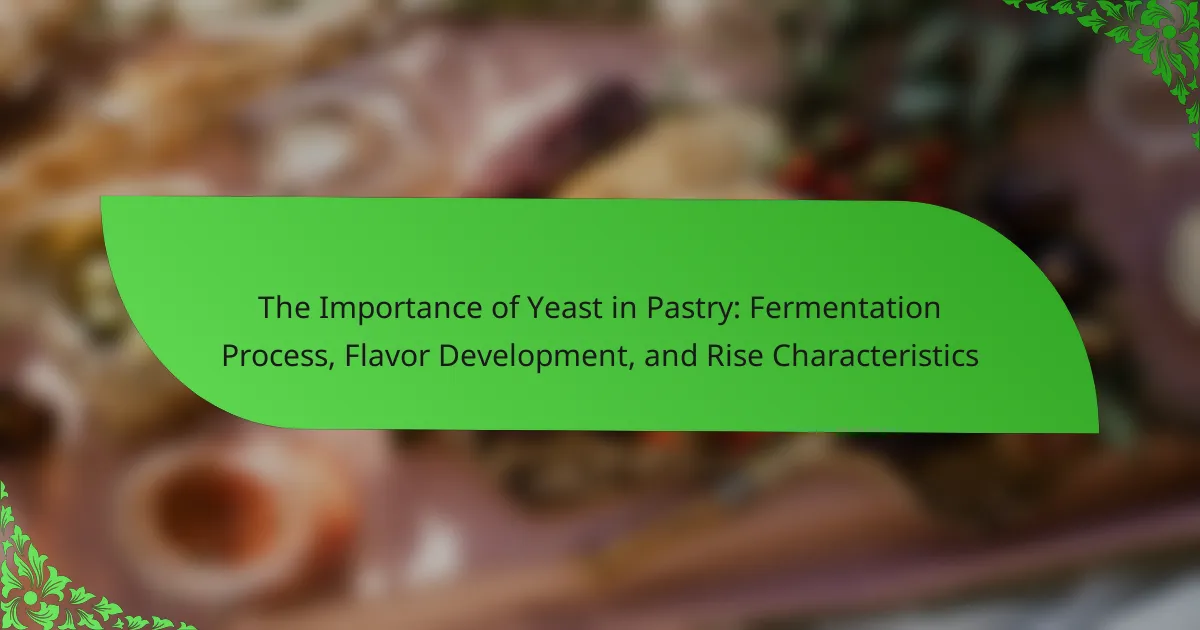Yeast is a vital ingredient in pastry, primarily functioning as a leavening agent through the fermentation of sugars in the dough. This process generates carbon dioxide gas, which causes the dough to rise, contributing to its airy texture and enhancing flavor development. The article explores the significance of yeast in pastry, detailing its impact on texture, flavor, and crust browning via the Maillard reaction. It also examines various types of yeast, including active dry yeast, instant yeast, and fresh yeast, highlighting their unique characteristics and roles in the fermentation process. Understanding yeast management is essential for pastry chefs to achieve consistent quality and desired baking outcomes.

What is the role of yeast in pastry?
Yeast is a crucial ingredient in pastry, primarily serving as a leavening agent. It ferments sugars present in the dough, producing carbon dioxide gas. This gas gets trapped in the dough, causing it to rise and become airy. The fermentation process also contributes to flavor development, enhancing the overall taste of the pastry. Yeast activity can improve texture, making pastries light and flaky. Additionally, it helps in browning the crust during baking through the Maillard reaction. The importance of yeast in pastry is thus evident in its role in leavening, flavor, and texture enhancement.
How does yeast contribute to the fermentation process in pastry?
Yeast contributes to the fermentation process in pastry by converting sugars into carbon dioxide and alcohol. This process is known as alcoholic fermentation. The carbon dioxide produced creates gas bubbles, which cause the dough to rise. Yeast also enhances flavor through the production of various compounds during fermentation. These compounds include esters and phenols, contributing to the aroma and taste of the pastry. Additionally, fermentation improves the texture by developing gluten structure. The overall result is a light, airy pastry with a complex flavor profile.
What are the stages of fermentation in pastry making?
The stages of fermentation in pastry making include mixing, bulk fermentation, shaping, and final fermentation. During mixing, ingredients are combined to create a dough. The bulk fermentation stage allows the dough to rise and develop flavor. Shaping involves forming the dough into desired shapes. Finally, final fermentation occurs before baking, allowing for additional rise. Each stage is crucial for achieving proper texture and taste in the pastry.
How does yeast metabolism affect dough characteristics?
Yeast metabolism significantly influences dough characteristics through fermentation. During fermentation, yeast converts sugars into carbon dioxide and alcohol. This process creates gas bubbles in the dough, leading to its rise. The production of carbon dioxide is crucial for leavening, which results in a light and airy texture.
Additionally, yeast metabolism contributes to flavor development. The byproducts of fermentation, such as organic acids and alcohol, enhance the taste profile of the dough. These compounds add complexity and depth to the flavor.
The temperature and duration of fermentation also affect dough characteristics. Warmer temperatures speed up yeast activity, resulting in faster fermentation. This can lead to a more pronounced flavor but may affect the dough’s structure if over-fermented.
Research indicates that optimal fermentation times improve dough elasticity and extensibility. This is essential for achieving the desired texture in baked goods. Overall, yeast metabolism is vital for the physical and sensory qualities of dough.
What flavors does yeast develop in pastry?
Yeast develops a range of flavors in pastry, primarily through fermentation. These flavors include fruity esters, nutty notes, and complex aromas. The fermentation process allows yeast to produce compounds like alcohol and carbon dioxide. These compounds contribute to the overall taste and texture of the pastry. For example, esters can impart fruity flavors such as banana or apple. Additionally, the Maillard reaction during baking enhances the nutty and toasted flavors. The specific strains of yeast used can influence the flavor profile as well. Overall, yeast plays a crucial role in flavor development in pastry.
How do different yeast strains influence flavor profiles?
Different yeast strains significantly influence flavor profiles in baked goods. Each strain produces unique compounds during fermentation. For example, Saccharomyces cerevisiae is known for producing fruity esters. These esters can impart flavors like banana or apple. In contrast, wild yeast strains often contribute more complex, sour, or earthy notes. The fermentation temperature also affects flavor; warmer temperatures can enhance ester production. Additionally, the duration of fermentation influences flavor intensity. Longer fermentation times can deepen flavors and create more nuanced profiles. Studies show that the choice of yeast can alter the perception of sweetness and acidity in pastries.
What are the key byproducts of yeast fermentation that enhance flavor?
The key byproducts of yeast fermentation that enhance flavor include alcohol, carbon dioxide, and various organic acids. Alcohol contributes a distinct taste and aroma to baked goods. Carbon dioxide is responsible for leavening, which indirectly affects texture and flavor perception. Organic acids, such as acetic and lactic acid, add complexity and depth to the flavor profile. These byproducts are produced during the metabolic processes of yeast, particularly during anaerobic fermentation. The presence of these compounds is crucial in developing the characteristic flavors found in many pastries.
What are the rise characteristics provided by yeast in pastry?
Yeast provides leavening characteristics in pastry through fermentation. During fermentation, yeast consumes sugars and produces carbon dioxide gas. This gas gets trapped in the dough, causing it to expand and rise. The rise contributes to the light and airy texture of pastries. Yeast also enhances flavor development through the production of alcohol and organic acids. These compounds add complexity to the taste. The rise characteristics are crucial for achieving the desired structure in various pastry types.
How does yeast impact the texture and volume of pastry?
Yeast significantly impacts the texture and volume of pastry. It acts as a leavening agent, producing carbon dioxide during fermentation. This gas creates bubbles in the dough, causing it to rise. The expansion of the dough leads to a lighter and airier texture. Yeast also contributes to the development of gluten, which adds structure to the pastry. A well-developed gluten network improves the overall texture and chewiness. Additionally, the fermentation process enhances flavor, making the pastry more appealing. Studies show that yeast fermentation can increase volume by up to 50%. This combination of factors results in pastries that are both fluffy and flavorful.
What factors affect the rise of pastry during baking?
The rise of pastry during baking is primarily affected by yeast activity, temperature, and moisture content. Yeast produces carbon dioxide gas through fermentation, which causes the dough to expand. The optimal temperature for yeast activation is typically between 75°F to 85°F. If the temperature is too low, yeast activity slows down, resulting in insufficient rise. Conversely, excessive heat can kill the yeast, halting the rising process.
Moisture content is also crucial; too little moisture can lead to a dry pastry, while too much can create a sticky texture. Additionally, the type of flour used influences the rise. High-protein flours develop more gluten, which traps gas better and enhances the rise. Finally, the presence of sugar can affect yeast performance, as it serves as food for the yeast, promoting fermentation and gas production.

Why is understanding yeast important for pastry chefs?
Understanding yeast is crucial for pastry chefs because it directly affects the fermentation process and final product quality. Yeast is a living organism that ferments sugars, producing carbon dioxide and alcohol. This fermentation process is essential for creating the desired texture and rise in pastries. Proper yeast management ensures consistent results in dough development. It influences flavor through the production of various compounds during fermentation. Knowledge of yeast types and their characteristics allows chefs to select the best option for specific recipes. For instance, active dry yeast and instant yeast have different hydration needs and fermentation rates. Mastering yeast behavior leads to improved control over baking outcomes.
How can pastry chefs optimize yeast usage in their recipes?
Pastry chefs can optimize yeast usage by adjusting the fermentation time and temperature. Proper fermentation enhances flavor and texture. Chefs should also measure yeast accurately based on the recipe’s hydration level. Using the right type of yeast, such as instant or active dry, can improve efficiency. Additionally, incorporating preferments like poolish or biga can boost yeast activity. Monitoring dough hydration helps in yeast performance, as wetter doughs can ferment faster. Finally, understanding the dough’s environment, such as humidity and temperature, allows for better yeast management. These methods ensure effective yeast usage in pastry recipes.
What are best practices for activating and incorporating yeast?
To activate and incorporate yeast effectively, begin by using warm water between 100°F and 110°F. This temperature range is optimal for yeast activation. Next, dissolve sugar in the warm water before adding the yeast. Sugar serves as food for the yeast, promoting faster activation. Allow the mixture to sit for about 5 to 10 minutes. This waiting period enables the yeast to foam, indicating it is active.
When incorporating yeast into dough, mix it with flour and other dry ingredients. Ensure the dry ingredients are well combined to distribute the yeast evenly. Gradually add liquid ingredients while mixing to maintain an even consistency. Knead the dough thoroughly for about 8 to 10 minutes. Kneading develops gluten, which supports the structure during fermentation.
Proofing the dough is essential. Allow it to rise in a warm, draft-free area until it doubles in size. This process typically takes 1 to 2 hours. Proper proofing leads to better flavor and texture in the final product. Following these practices ensures successful yeast activation and incorporation, crucial for achieving desired fermentation and rise in pastries.
How can temperature and humidity affect yeast performance?
Temperature and humidity significantly influence yeast performance during fermentation. Optimal temperatures for yeast activity range from 75°F to 85°F. At these temperatures, yeast ferments sugars efficiently, producing carbon dioxide and alcohol. Higher temperatures, above 90°F, can lead to yeast stress and reduced fermentation rates. Conversely, temperatures below 70°F slow down yeast activity, resulting in sluggish fermentation.
Humidity also plays a crucial role. High humidity levels can enhance yeast performance by preventing dough from drying out. This allows yeast to thrive and produce gas effectively. However, excessive humidity can lead to over-hydration of the dough, affecting texture and rise.
Research indicates that maintaining proper temperature and humidity levels is essential for optimal yeast fermentation. Studies show that a 10°F increase in temperature can double yeast activity, while humidity levels above 60% support better fermentation outcomes.
What common challenges do bakers face with yeast in pastry?
Bakers commonly face challenges with yeast in pastry, including improper activation, temperature control, and ingredient interactions. Improper activation occurs when yeast is not adequately dissolved or is exposed to extreme temperatures. Yeast requires specific temperatures, typically between 75°F and 115°F, for optimal fermentation. If the dough is too cold, yeast activity slows down. Conversely, excessive heat can kill the yeast. Ingredient interactions can also hinder yeast performance. For example, high sugar concentrations can inhibit yeast growth, while excessive salt can weaken yeast activity. Additionally, using expired or inactive yeast can lead to poor rise and texture. These challenges directly affect the final quality of the pastry.
How can bakers troubleshoot yeast-related issues?
Bakers can troubleshoot yeast-related issues by checking the yeast’s freshness, temperature, and hydration. Fresh yeast is crucial for effective fermentation. If the yeast is expired, it may not activate properly.
Temperature affects yeast activity significantly. Ideal temperatures range from 75°F to 85°F for optimal fermentation. If the dough is too cold, yeast will be sluggish. Conversely, excessive heat can kill the yeast.
Hydration is also essential. Yeast needs moisture to activate. If the dough is too dry, the yeast will not perform well. Adding water gradually can help achieve the right consistency.
Bakers should also monitor the dough’s rise. If it does not rise, it may indicate inactive yeast or insufficient time. Allowing more time for fermentation can resolve this issue.
Lastly, checking the dough’s pH can help. A too acidic environment can hinder yeast activity. Adjusting the ingredients can create a more favorable pH level.
What signs indicate problems with yeast in pastry dough?
Signs that indicate problems with yeast in pastry dough include a lack of rise, dense texture, and off odors. If the dough does not double in size during proofing, it suggests inactive yeast. A dense texture in the final product indicates insufficient fermentation. Off odors may signal spoilage or contamination. Additionally, if the dough has a dry surface or cracks, it may indicate yeast failure. Proper yeast activity is crucial for achieving the desired light and airy pastry.

What are the different types of yeast used in pastry making?
The different types of yeast used in pastry making include active dry yeast, instant yeast, and fresh yeast. Active dry yeast is dehydrated and requires proofing in warm water before use. Instant yeast can be mixed directly with dry ingredients and does not require proofing. Fresh yeast, also known as cake yeast, is a moist form that has a shorter shelf life but provides a rich flavor. Each type contributes uniquely to the fermentation process and flavor development in pastries. For instance, active dry yeast typically takes longer to rise than instant yeast. Fresh yeast is often preferred by professional bakers for its potency and flavor profile.
What are the characteristics of active dry yeast?
Active dry yeast is a dehydrated form of yeast used in baking. It contains live Saccharomyces cerevisiae cells that become active when rehydrated. This yeast is known for its long shelf life, typically lasting up to two years when stored properly. Active dry yeast requires warm water to activate, usually around 100°F to 110°F. It is available in granulated form and needs to be dissolved before use. The fermentation process produces carbon dioxide, causing dough to rise. This yeast contributes to flavor development through fermentation byproducts. It has a moderate fermentation rate, suitable for various bread and pastry recipes.
How does active dry yeast compare to instant yeast?
Active dry yeast and instant yeast are both types of dry yeast used in baking. Active dry yeast requires proofing before use, while instant yeast can be mixed directly into dry ingredients. Active dry yeast typically has larger granules compared to the finer texture of instant yeast. The fermentation speed of instant yeast is generally faster, leading to quicker rise times in dough. Instant yeast also has a higher percentage of live cells, resulting in a more vigorous fermentation process. Both types can be substituted for one another, but adjustments may be needed in liquid and rising times.
What is the role of fresh yeast in pastry?
Fresh yeast in pastry serves as a leavening agent. It ferments sugars present in the dough, producing carbon dioxide gas. This gas creates bubbles that cause the pastry to rise. Fresh yeast also contributes to flavor development during fermentation. The fermentation process enhances the texture and aroma of the pastry. Typically, fresh yeast is used in a 1:3 ratio compared to dry yeast. It is known for its quick action and effectiveness in doughs. The optimal temperature for fresh yeast activation is around 75°F to 80°F.
What are the advantages and disadvantages of using fresh yeast?
Fresh yeast has several advantages and disadvantages.
Advantages include a faster fermentation process. Fresh yeast activates quickly, leading to quicker dough rise. It also contributes to a rich flavor profile. The fresh yeast provides a unique taste that enhances baked goods. Additionally, it contains live cells that can improve the texture of the final product.
Disadvantages involve a shorter shelf life. Fresh yeast can spoil quickly if not stored properly. It requires refrigeration to maintain its potency. Moreover, fresh yeast is less convenient than dry yeast. It often demands precise measuring and handling. Lastly, fresh yeast can be more expensive and less accessible than other forms.
How can bakers choose the right yeast for their pastry needs?
Bakers can choose the right yeast for their pastry needs by considering the type of yeast and its characteristics. Common types include active dry yeast, instant yeast, and fresh yeast. Active dry yeast requires proofing in water before use. Instant yeast can be mixed directly with dry ingredients and offers a quicker rise. Fresh yeast provides a mild flavor and is often used in professional baking.
Bakers should also evaluate the fermentation time required for their recipes. Some pastries benefit from a slow fermentation for enhanced flavor. Others may need a quick rise for efficiency. The desired texture of the pastry plays a crucial role as well. Rich doughs may require a different yeast than lean doughs.
Additionally, bakers should consider the temperature at which the dough will be proofed. Yeast activity is temperature-sensitive, impacting rise and flavor. By matching the yeast type to the specific pastry needs and conditions, bakers can achieve optimal results.
What factors should be considered when selecting yeast for specific pastry types?
When selecting yeast for specific pastry types, factors include fermentation rate, flavor profile, and dough strength. Different pastries require distinct fermentation times. For example, quick breads benefit from fast-acting yeast. Flavor development is crucial; some yeasts enhance sweetness while others add complexity. Dough strength affects the structure; high-gluten pastries need robust yeast. Temperature tolerance is also important; some yeasts perform better in warmer conditions. Additionally, the desired texture influences yeast choice; light pastries may require specific strains for optimal rise. Ultimately, understanding these factors ensures the right yeast is selected for each pastry type.
What practical tips can enhance the use of yeast in pastry?
To enhance the use of yeast in pastry, ensure proper activation by using warm water between 100°F to 110°F. This temperature range optimally activates yeast cells. Additionally, incorporate sugar to feed the yeast, promoting fermentation and flavor development. Allow adequate proofing time, typically 1 to 2 hours, for dough to rise properly. Use fresh yeast for better performance; expired yeast may lead to poor results. Knead the dough thoroughly to develop gluten, which supports the structure. Maintain a warm, draft-free environment during rising to encourage yeast activity. Finally, avoid overworking the dough after the first rise to preserve air pockets.
The primary entity of this article is yeast, specifically its role in pastry making. Yeast acts as a leavening agent through fermentation, producing carbon dioxide that causes dough to rise, while also enhancing flavor and texture. The article explores the fermentation process, detailing stages and factors affecting yeast activity, and discusses how different yeast strains influence flavor profiles. Additionally, it provides practical tips for bakers on optimizing yeast usage and troubleshooting common challenges, emphasizing the importance of understanding yeast for achieving high-quality pastries.
